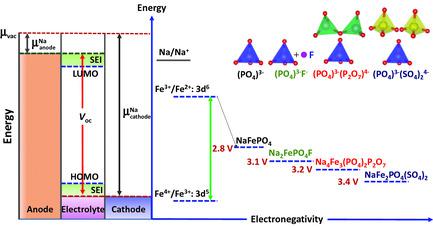当前位置:
X-MOL 学术
›
Small Methods
›
论文详情
Our official English website, www.x-mol.net, welcomes your feedback! (Note: you will need to create a separate account there.)
An Overview of Mixed Polyanionic Cathode Materials for Sodium‐Ion Batteries
Small Methods ( IF 12.4 ) Pub Date : 2018-09-17 , DOI: 10.1002/smtd.201800253 Baskar Senthilkumar 1 , Chinnasamy Murugesan 1 , Lalit Sharma 1 , Shubham Lochab 1 , Prabeer Barpanda 1
Small Methods ( IF 12.4 ) Pub Date : 2018-09-17 , DOI: 10.1002/smtd.201800253 Baskar Senthilkumar 1 , Chinnasamy Murugesan 1 , Lalit Sharma 1 , Shubham Lochab 1 , Prabeer Barpanda 1
Affiliation

|
“Building better batteries” remains an ongoing process to cater diverse energy demands starting from small‐scale consumer electronics to large‐scale automobiles and grid storage. While Li‐ion batteries have carried this burden over the last three decades, the ever‐growing and highly diverse applications (based on size, energy‐density, and stationary vs mobile usages) have led to an era of “beyond lithium‐ion batteries.” In this postlithium‐battery era, sodium‐ion batteries (NIBs) have emerged as a pragmatic option particularly for large‐scale applications. They attract attention due to the abundance and uniform geographic distribution of sodium‐based minerals, materials/process economy, and well‐known (de)intercalation mechanisms, in particular for stationary applications independent of size/weight restriction. Parallel to the Li‐ion batteries, the cathode (positive electrode) plays a key role in overall performance, leading to the exploration of various layered and 3D framework insertion materials. While layered oxides deliver high capacity, polyanionic hosts offer structural stability, operational safety, and tunable redox potentials. It can be further exploited in “mixed polyanion” cathode materials combining more than one kind of polyanion units. This article focuses on mixed polyanionic cathode materials for NIBs. It renders a sneak‐peek on suites of mixed polyanionic insertion materials discussing their structure, overall electrochemical performance, and future perspectives.
中文翻译:

钠离子电池用混合聚阴离子阴极材料概述
从小型消费类电子产品到大型汽车和电网存储,“制造更好的电池”仍然是一个满足各种能源需求的持续过程。在过去的三十年中,锂离子电池承担了这一重担,但不断增长的高度多样化的应用(基于尺寸,能量密度以及固定与移动用途)导致了“超越锂离子电池”的时代。” 在这个后锂电池时代,钠离子电池(NIB)逐渐成为一种实用的选择,尤其是对于大型应用。由于钠基矿物的丰富和均匀的地理分布,材料/工艺的经济性以及众所周知的(脱)插层机理,特别是对于不受尺寸/重量限制的固定式应用,它们引起了人们的关注。与锂离子电池平行 阴极(正电极)在整体性能中起着关键作用,从而导致对各种分层和3D框架插入材料的探索。层状氧化物提供高容量,而聚阴离子主体则提供结构稳定性,操作安全性和可调的氧化还原电位。可以在结合了一种以上聚阴离子单元的“混合聚阴离子”阴极材料中进一步利用它。本文重点介绍用于NIB的混合聚阴离子阴极材料。它简要介绍了混合的聚阴离子插入材料套件,讨论了它们的结构,整体电化学性能以及未来的前景。聚阴离子主体可提供结构稳定性,操作安全性和可调的氧化还原电位。可以在结合了一种以上聚阴离子单元的“混合聚阴离子”阴极材料中进一步利用它。本文重点介绍用于NIB的混合聚阴离子阴极材料。它简要介绍了混合的聚阴离子插入材料套件,讨论了它们的结构,整体电化学性能以及未来的前景。聚阴离子主体可提供结构稳定性,操作安全性和可调的氧化还原电位。可以在结合了一种以上聚阴离子单元的“混合聚阴离子”阴极材料中进一步利用它。本文重点介绍用于NIB的混合聚阴离子阴极材料。它简要介绍了混合的聚阴离子插入材料套件,讨论了它们的结构,整体电化学性能以及未来的前景。
更新日期:2018-09-17
中文翻译:

钠离子电池用混合聚阴离子阴极材料概述
从小型消费类电子产品到大型汽车和电网存储,“制造更好的电池”仍然是一个满足各种能源需求的持续过程。在过去的三十年中,锂离子电池承担了这一重担,但不断增长的高度多样化的应用(基于尺寸,能量密度以及固定与移动用途)导致了“超越锂离子电池”的时代。” 在这个后锂电池时代,钠离子电池(NIB)逐渐成为一种实用的选择,尤其是对于大型应用。由于钠基矿物的丰富和均匀的地理分布,材料/工艺的经济性以及众所周知的(脱)插层机理,特别是对于不受尺寸/重量限制的固定式应用,它们引起了人们的关注。与锂离子电池平行 阴极(正电极)在整体性能中起着关键作用,从而导致对各种分层和3D框架插入材料的探索。层状氧化物提供高容量,而聚阴离子主体则提供结构稳定性,操作安全性和可调的氧化还原电位。可以在结合了一种以上聚阴离子单元的“混合聚阴离子”阴极材料中进一步利用它。本文重点介绍用于NIB的混合聚阴离子阴极材料。它简要介绍了混合的聚阴离子插入材料套件,讨论了它们的结构,整体电化学性能以及未来的前景。聚阴离子主体可提供结构稳定性,操作安全性和可调的氧化还原电位。可以在结合了一种以上聚阴离子单元的“混合聚阴离子”阴极材料中进一步利用它。本文重点介绍用于NIB的混合聚阴离子阴极材料。它简要介绍了混合的聚阴离子插入材料套件,讨论了它们的结构,整体电化学性能以及未来的前景。聚阴离子主体可提供结构稳定性,操作安全性和可调的氧化还原电位。可以在结合了一种以上聚阴离子单元的“混合聚阴离子”阴极材料中进一步利用它。本文重点介绍用于NIB的混合聚阴离子阴极材料。它简要介绍了混合的聚阴离子插入材料套件,讨论了它们的结构,整体电化学性能以及未来的前景。



























 京公网安备 11010802027423号
京公网安备 11010802027423号